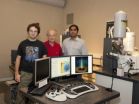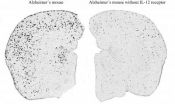Crash landings
2012-11-26
(Press-News.org) Diagnosing an injury in a swan is a far from easy undertaking. Not only are swans large, frequently weighing over 10 kg, but they are generally not happy at being handled and thus many of them can only be examined after sedation, which naturally represents a risk. The hip joints of many species of bird are known to be vulnerable to injury but swans are believed to suffer broken hips only rarely. The traditional way of examining the birds' hips relies on radiography but Gumpenberger and Scope now show that computerized tomography (CT) gives more reliable findings.
The researchers examined the hip joints of five swans that had been brought to the Clinic for Avian, Reptile and Fish Medicine of the University of Veterinary Medicine, Vienna because they were unable to stand. Radiographs were taken of three of the birds, while all of them were subjected to CT scans. The results were highly illuminating. Radiography gave indications that one of the swans might have problems with its hip joint but the diagnosis was not conclusive and the other two swans examined seemed to have intact joints. In contrast, CT showed correctly that all five swans had lesions of the hip.
Computerized tomography is thus much better able to identify problems with the hip joint than classical radiographic methods. In addition, it is often less stressful for the animals: imaging can be performed without the need for narcosis by simply placing the bird in a darkened cardboard box and allowing it to sit comfortably, whereas radiography of many species requires their sedation.
It seems, then, that hip problems in swans are more common than previously believed. It is likely that the majority of injuries of this kind arise when the birds attempt to land on hard surfaces, when the landing forces are transmitted through their legs to their hips. Of course, such emergency landings may simply be the result of air turbulence but Gumpenberger notes that "many injured swans are found near roads or railway lines, so it is possible that they misinterpret shiny rails or even concrete road surfaces as being water and thus try to land."
The paper "Computed tomography of coxofemoral injury in five mute swans (Cygnus olor)" by Michaela Gumpenberger and Alexandra Scope is published in the journal "Avian Pathology" (Vol. 41(5), 465-468).
###
Abstract of the scientific article online (full text for a fee or with a subscription):
http://www.tandfonline.com/doi/abstract/10.1080/03079457.2012.712205
About the University of Veterinary Medicine, Vienna
The University of Veterinary Medicine, Vienna is the only academic and research institution in Austria that focuses on the veterinary sciences. About 1000 employees and 2300 students work on the campus in the north of Vienna, which also houses the animal hospital and various spin-off-companies.
http://www.vetmeduni.ac.at
Distributed by:
Klaus Wassermann
Public Relations/Science Communication
University of Veterinary Medicine, Vienna
T 43-250-771-153
klaus.wassermann@vetmeduni.ac.at
ELSE PRESS RELEASES FROM THIS DATE:
2012-11-26
The latest correspondence is posted online today as part of the BMJ's open data campaign, aimed at persuading Roche to honour the promise it made almost three years ago to make key Tamiflu trial data available for independent scrutiny.
Last week, Donald MacLean, Life Cycle Leader for Tamiflu, wrote to Professor Chris Del Mar in his capacity as coordinating editor of the Cochrane Acute Respiratory Infections Group, concerning "our debate on Tamiflu data."
The Cochrane researchers say they object to Roche's suggestion that there is a debate on Tamiflu data. "There is ...
2012-11-26
BUFFALO, N.Y. -- A new University at Buffalo study in the journal Geophysical Research Letters examines maar craters, which resemble the bowl-like cavities formed by meteorites but are in some ways more mysterious.
Scientists often can discern pertinent details about meteorites -- when they struck, how large they were, the angle they approached Earth and other information -- by measuring the diameter and volume of the impact crater.
Maar craters, which form when fissures of magma beneath Earth's surface meet groundwater, causing volcanic explosions, are not as telling, ...
2012-11-26
Researchers at the University of California, Santa Cruz, have developed a new strategy for finding novel antibiotic compounds, using a diagnostic panel of bacterial strains for screening chemical extracts from natural sources.
Public health officials warn of a looming antibiotic crisis due to the steady increase in antibiotic resistance and a dramatic decline in the development of new antibiotics. Most currently available antibiotics are derived from natural compounds produced by microorganisms such as bacteria and fungi. New antibiotics developed by drug companies are ...
2012-11-26
Cambridge, Mass. - November 26, 2012 - Now you see it, now you don't.
A new device invented at the Harvard School of Engineering and Applied Sciences (SEAS) can absorb 99.75% of infrared light that shines on it. When activated, it appears black to infrared cameras.
Composed of just a 180-nanometer-thick layer of vanadium dioxide (VO2) on top of a sheet of sapphire, the device reacts to temperature changes by reflecting dramatically more or less infrared light.
Announced today in the journal Applied Physics Letters, and featured on its cover, this perfect absorber ...
2012-11-26
Two drugs commonly given during cardiac surgery can lead to convulsive seizures, but anesthetics can help cut the risk, according to new research from the Faculty of Medicine at the University of Toronto.
Patients undergoing complex heart operations or trauma surgery are often given tranexamic acid (TXA) and aminocaproic acid (EACA) to reduce blood loss. But Faculty of Medicine researchers found these drugs are associated with a four-to-six-fold increase in post-operative seizures. The risk is highest for cardiac surgery patients – between three and seven and a half per ...
2012-11-26
LOS ALAMOS, N.M., Nov. 26, 2012 — A team of researchers, including engineers from Los Alamos National Laboratory, has demonstrated a new concept for a reliable nuclear reactor that could be used on space flights.
The research team recently demonstrated the first use of a heat pipe to cool a small nuclear reactor and power a Stirling engine at the Nevada National Security Site's Device Assembly Facility near Las Vegas. The Demonstration Using Flattop Fissions (DUFF) experiment produced 24 watts of electricity. A team of engineers from Los Alamos, the NASA Glenn Research ...
2012-11-26
Cyber Monday is here and it brings one last chance for electronic cigarette fans to save big on all of their favorite e-cig starter kits and accessories. CocktailNerd.com is offering readers big savings on Cyber Monday with exclusive deals that will expire at midnight. This is the year's biggest sale on all of the best electronic cigarettes brands and with exclusive coupon codes from Cocktail Nerd, e-cig shoppers can save up to 65% on all of their favorite products.
Cocktail Nerd is the Internet's most cutting edge website for e-cig news, reviews, and savings. The site ...
2012-11-26
Alzheimer's disease is one of the most common causes of dementia. In Germany and Switzerland alone, around 1.5 million people are affected, and forecasts predict a doubling of the number of patients worldwide within the next 20 years. The accumulation of particular abnormal proteins, including amyloid-ß (Aβ) among others, in patients' brains plays a central role in this disease. Prof. Frank Heppner from the Department of Neuropathology at Charité and his colleague Prof. Burkhard Becher from the Institute for Experimental Immunology at the University of Zurich were ...
2012-11-26
COLUMBUS, Ohio – Doctors now use cancer-killing viruses to treat some patients with lethal, fast-growing brain tumors. Clinical trials show that these therapeutic viruses are safe but less effective than expected.
A new study led by researchers at the Ohio State University Comprehensive Cancer Center – Arthur G. James Cancer Hospital and Richard J. Solove Research Institute (OSUCCC – James) shows that the reason for this is in part due to the patient's own immune system, which quickly works to eliminate the anticancer virus.
The findings, published in the journal Nature ...
2012-11-26
(Philadelphia, PA) – A team of scientists from Temple University School of Medicine and the University of Pennsylvania has moved another step closer to solving a decades-long mystery of how the all-important flow of calcium into the cell's power source, the mitochondria, is controlled.
By painstakingly shutting down the activity of 50 genes, one at a time, they have identified a protein, MCUR1, which hugs the inside of the mitochondrial membrane and is part of an elaborate mitochondrial channel pore system. MCUR1 acts as an accelerator to help regulate calcium coming ...
LAST 30 PRESS RELEASES:
[Press-News.org] Crash landings

